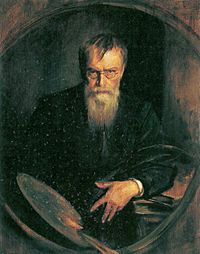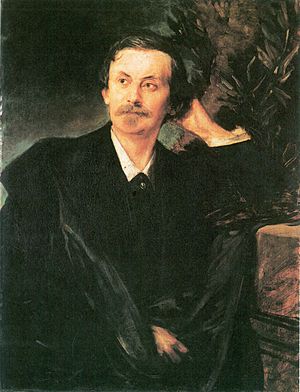Franz von Lenbach facts for kids
Quick facts for kids
Franz von Lenbach
|
|
|---|---|

Self-portrait (1903)
|
|
| Born | 13 December 1836 Schrobenhausen, Kingdom of Bavaria
|
| Died | 6 May 1904 (aged 67) |
| Nationality | German |
| Known for | Painting |
Franz Seraph Lenbach, who later became Ritter von Lenbach in 1882, was a famous German painter. He was born on December 13, 1836, and passed away on May 6, 1904. He was best known for painting portraits of important people. These included kings, queens, artists, and powerful business leaders. Because of his high standing in society, people often called him the "Malerfürst," which means "Painter Prince."
Becoming a Painter
Franz von Lenbach's father was a master builder from South Tyrol. Franz was born in Schrobenhausen. He finished his basic schooling in Landsberg am Lech in 1848. After that, he went to a business school in Landshut.
From 1851 to 1852, he trained with a sculptor named Anselm Sickinger in Munich. When his father died, Franz went home to help with the family business.
He didn't stay long before starting studies at the Augsburg University of Applied Sciences. In his free time, he loved to draw and paint. He became friends with Johann Baptist Hofner, an animal painter. This friendship helped him decide to become an artist. In 1854, his family finally agreed to let him study at the Academy of Fine Arts, Munich. He also took private lessons from Hermann Anschütz.
Lenbach was already a skilled artist when he became a student of Karl von Piloty. In 1858, he showed his art at the Glaspalast exhibition. He won a scholarship that allowed him to travel to Rome with Piloty. From this trip, some of his early works include A Peasant seeking Shelter from Bad Weather (1855) and The Arch of Titus (1860). Around this time, he also started getting his first requests to paint portraits.
Travels and Fame
After returning to Munich, Lenbach was asked to become a professor. He taught at the new Weimar Saxon Grand Ducal Art School in Weimar. He was known for taking his students outside to paint in nature, a style called en plein air. He only stayed for two years because he wanted to study more.
He decided to take another trip to Italy. During this time, he found an important supporter, Baron Adolf Friedrich von Schack. With the Baron's help, Lenbach could travel to Italy in 1863. He had a guaranteed income each year.
He came back to Munich in 1866. The next year, he won a gold medal at the Exposition Universelle in Paris. He then went to Spain for a year with his student, Ernst Friedrich von Liphart. There, he made copies of famous paintings by Old Masters (great artists from the past) for Baron Schack.
When he returned, his career as a portrait painter truly began. His big break came in 1869. He won another gold medal at the Glaspalast, even though he was competing against many popular French painters. After 1870, he often visited Vienna to find more people who wanted his paintings.
From 1875 to 1876, he traveled to Egypt with Hans Makart and other friends. This trip greatly influenced his painting style. In 1882, he received a special award, the Order of Merit of the Bavarian Crown. This award allowed him to add "Von" to his name, becoming "Von Lenbach."
The next year, he was back in Rome, living in the Palazzo Borghese. He painted a portrait of Clara Schumann in 1878. In 1885, he was asked to paint Pope Leo XIII. Since the Pope was very busy, Lenbach used a new technique. He created a painting from a photographic image. He left Rome in 1887 and started building a large house in Munich. Later that year, he married Countess Magdalena Moltke.
Later Life and Legacy
By the 1890s, Lenbach often painted from photographs. This was a common practice for artists at the time. He also started painting very quickly to earn more money. He later married Charlotte von Hornstein, the daughter of a composer.
Lenbach did not join the Munich Secession, a group of artists who wanted new styles. He also started painting women almost all the time, whereas before he focused more on men. Around 1900, he designed pictures for trading cards for a chocolate company.
In 1902, he became an honorary Knight in the Légion d’Honneur, a high award from France. That same year, he had a stroke while returning from his hometown. He never fully recovered. He passed away at his home in Munich two years later. He was buried at the Westfriedhof, and many important people attended his funeral.
Some of Lenbach's paintings are now in national art collections. These include portraits of Otto von Bismarck and William Ewart Gladstone in the National Galleries of Scotland. Another portrait of Gladstone is in the Palace of Westminster in the United Kingdom. Other works can be found in the Frye Art Museum in Seattle, Washington, USA.
Art in History
Lenbach's paintings were highly valued by important figures during the Third Reich era. They were often given as gifts. For example, a powerful leader received a Lenbach painting in 1936 and was very happy with it. Many of Lenbach's paintings were taken from their owners during this time. Later, efforts were made to find and return these artworks to their rightful owners. Databases now list many of his works that were affected.
See also
- Lenbachhaus
 In Spanish: Franz von Lenbach para niños
In Spanish: Franz von Lenbach para niños





